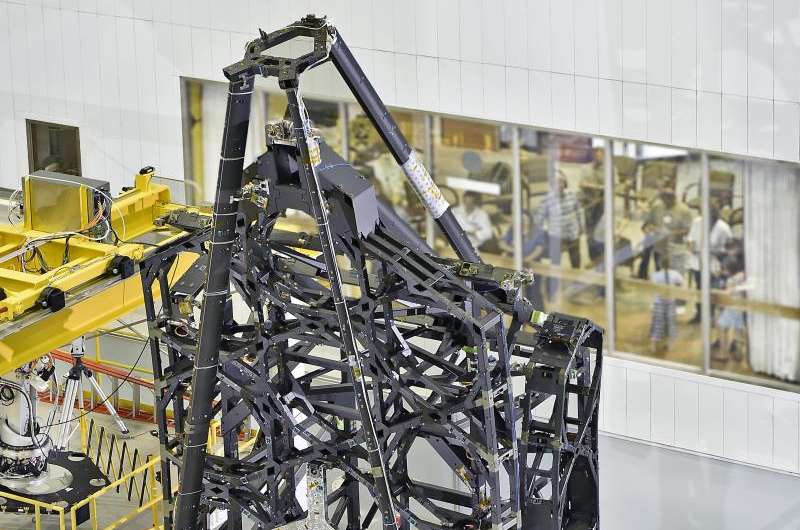NASA's James Webb Space Telescope structure stands tall

The flight structure of NASA's James Webb Space Telescope was standing tall on a platform in the cleanroom at NASA's Goddard Space Flight Center in Greenbelt, Maryland on August 30.
The telescope structure includes the primary mirror backplane assembly; the main backplane support fixture; and the deployable tower structure that lifts the telescope off of the spacecraft. The three arms at the top come together into a ring where the secondary mirror will reside.
Standing tall and standing up in the stowed-for-launch configuration as it appears in this photo, the complete telescope structure stretches about 26 feet (nearly 8 meters) from its base on the roll-over fixture to the secondary mirror support at the top. There is a yellow fixture at the bottom of the telescope structure that is designed to secure the bottom of the tower until the telescope structure is mounted on the spacecraft.
"The large structure serves as the central backbone that will soon be populated with mirrors in the final assembly of the telescope," said Lee Feinberg, Optical Telescope Element Manager for the Webb telescope at NASA's Goddard Space Flight Center in Greenbelt, Maryland.
In late fall, Webb's hexagonal flight mirrors will be placed by a robotic arm onto the backplane, which will hold the hexagonal mirrors and instruments steady while the telescope is looking into deep space. Together, those 18 mirrors make up Webb's 21-foot (6.5 meter) diameter "primary mirror."
Along with the secondary, tertiary, and fine steering mirrors, this primary mirror comprises a telescope that will help scientists observe the formation of the first stars and galaxies over 13.5 billion years ago.
In addition to the primary mirror, the backplane will also be carrying 7,500 pounds (2400 kg) of telescope optics and instruments. The backplane must keep the mirrors motionless in order to get clear images far in deep space. It was engineered to remain stationary down to about 1/10,000 the diameter of a human hair (32 nanometers) at temperatures colder than -400°F (-240°C), such as those experienced in space.
The flight backplane arrived at Goddard after undergoing integration and testing at Northrop Grumman Aerospace Systems in Redondo Beach, California. ATK designed, engineered and constructed the backplane at its facilities in Magna, Utah. Once the backplane arrived, it was inspected by engineers and then set upright using a giant crane in the clean room.
The James Webb Space Telescope is the scientific successor to NASA's Hubble Space Telescope. It will be the most powerful space telescope ever built. Webb is an international project led by NASA with its partners, the European Space Agency and the Canadian Space Agency.
Provided by NASA





















